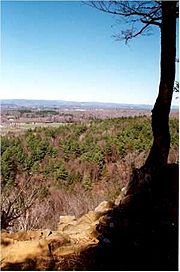West Suffield Mountain facts for kids
Quick facts for kids West Suffield Mountain |
|
|---|---|

View from West Suffield Mountain
|
|
| Highest point | |
| Elevation | est. 710 ft (220 m) ridge high point |
| Geography | |
| Location | Suffield, Connecticut |
| Parent range | Metacomet Ridge |
| Geology | |
| Age of rock | 200 Ma |
| Mountain type | Fault-block; igneous |
| Climbing | |
| Easiest route | Metacomet Trail |
West Suffield Mountain is a cool mountain ridge in north-central Connecticut. It's about 710 feet (220 m) tall. This mountain is part of the Metacomet Ridge, a long, narrow line of mountains. This ridge stretches from Long Island Sound all the way up to the Vermont border.
West Suffield Mountain is special because of its beautiful rocky ledges and thick forests. It also has unique mini-ecosystems and rare plants. You can hike on the 51-mile (82 km) Metacomet Trail here. The even longer 110-mile (180 km) Metacomet-Monadnock Trail starts nearby.
Contents
Where is West Suffield Mountain Located?
West Suffield Mountain rises sharply from the land around it. It stands 250 and 550 feet (76 and 168 m) above the Connecticut River Valley to its east. The highest point is 710 feet (220 m) above sea level. This mountain is about 4 miles (6 km) long and 1 mile (1½ km) wide.
The mountain is entirely within the town of Suffield, Connecticut. It stretches south from the Connecticut border. To its north, the Metacomet Ridge continues as Provin Mountain. To its south, it connects with Peak Mountain. Water from the northwest side of West Suffield Mountain flows into Congamond Lake. From there, it goes to the Westfield River, then the Connecticut River, and finally to Long Island Sound. Water from the south and west sides flows into Salmon Brook, then the Farmington River, and also to the Connecticut River. The east side of the mountain drains directly into the Connecticut River.
How West Suffield Mountain Was Formed
West Suffield Mountain is made of a type of rock called basalt. Basalt is also known as traprock. This rock comes from volcanic activity. The mountain formed about 200 million years ago. This was when the North American continent started to pull away from Africa and Eurasia.
During this time, hot Lava flowed up from deep cracks in the Earth. This lava cooled and hardened into thick layers of rock. Later, faults (cracks in the Earth's crust) and earthquakes caused these rock layers to tilt. This tilting created the steep cliffs and the long ridge of West Suffield Mountain that we see today.
Unique Plants and Animals
The mountain has different types of environments. The upper slopes are hot and dry. The ravines (small valleys) are cool and moist. The rocky ledges have special minerals. This mix creates many different microclimates. These tiny climates support plants and animals that are rare in other parts of Connecticut. West Suffield Mountain is also an important path for raptors (birds of prey) when they migrate. You can learn more about the geology and ecosystems of this area on the Metacomet Ridge page.
Protecting and Enjoying West Suffield Mountain
The 51-mile (82 km) Metacomet Trail runs along West Suffield Mountain. The Connecticut Forest and Park Association takes care of this trail. It's a great place for hiking, snowshoeing, and picnicking. From the high ledges, you can enjoy amazing views of the countryside.
One of the biggest challenges for West Suffield Mountain is suburban sprawl. This is when towns grow outwards, and more homes are built. Building houses on the ridgetops can harm the mountain's unique ecosystem and natural beauty. Even though much of the mountain is privately owned, people are working to protect it. Groups like the town of Suffield and the Suffield Land Conservancy have saved important parts of the mountain.
In 2000, West Suffield Mountain was studied by the National Park Service. They were looking at creating a new long-distance trail. This trail is now called the New England National Scenic Trail. It would connect the Metacomet-Monadnock Trail in Massachusetts with the Mattabesett Trail and Metacomet Trail in Connecticut.
Images for kids


